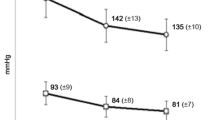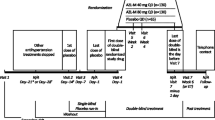Abstract
Introduction: The addition of the direct renin inhibitor aliskiren is demonstrated to improve blood pressure (BP) control rate and reduce progression of organ damage in treated hypertensive patients in clinical trials with a relatively short follow-up period.
Aim: The objective of this study was to assess the effectiveness, safety and tolerability of aliskiren as an addon antihypertensive therapy in high-risk, treated, hypertensive patients, who were not controlled with concomitant treatment with at least two antihypertensive drugs under ‘real-life’ conditions, during a planned observation and treatment period of at least 12 months in Italy.
Methods: Clinical data were derived from medical databases of treated, uncontrolled, hypertensive patients followed by specialized physicians operating in different clinical settings (hospital divisions or outpatient clinics) in Italy. Aliskiren was added to stable antihypertensive treatment, including at least two drug classes (independently of class or dosage) and unable to achieve BP control. Follow-up visits for measuring clinic BP levels and collecting data on drug safety and tolerability were planned at time intervals of 1, 6 and 12 months. At each predefined follow-up visit, aliskiren could be up-titrated from 150 to 300 mg daily if BP control was not achieved.
Results: From May 2009 to June 2011, a total of 1186 treated, uncontrolled, hypertensive patients (46.3% female, aged 65.2±11.7 years, mean duration of hypertension 13.2±9.3 years, mean clinic BP levels 156.5±15.9/90.3±9.5mmHg) were enrolled. Systolic and diastolic BP levels were 141.1/82.4, 134.9/79.8 and 133.6/78.9 mmHg at 1-, 6- and 12-month follow-up visits, respectively (p<0.0001 vs baseline for all comparisons). These effects were consistent in all predefined subgroups, including those with left ventricular hypertrophy, renal disease, diabetes mellitus, coronary artery disease or cerebrovascular disease. Reduced levels of microalbuminuria were also reported, without affecting other renal and electrolyte parameters. Overall, compliance to study medication was high (93.0%), with a very low proportion of patients experiencing adverse events leading to drug discontinuation (3.6%).
– In this observational, prospective, open-label, multicentre study, we reported the 12-month clinical effectiveness, safety and tolerability of adding aliskiren to treated, uncontrolled, hypertensive patients in a ‘real-life’ setting in Italy. This strategy leads to a significantly improved BP control rate and low incidence of drug-related side effects or discontinuations.








Similar content being viewed by others
References
Staessen JA, Wang J, Bianchi G, et al. Essential hypertension. Lancet 2003 May 10; 361 (9369): 1629–41.
Turnbull F, Neal B, Ninomiya T, et al. Effects of different regimens to lower blood pressure on major cardiovascular events in older and younger adults: meta-analysis of randomised trials. BMJ 2008 May 17; 336 (7653): 1121–3.
Turnbull F, Neal B, Algert C, et al. Effects of different blood pressure-lowering regimens on major cardiovascular events in individuals with and without diabetes mellitus: results of prospectively designed overviews of randomized trials. Arch Intern Med 2005 Jun 27; 165 (12): 1410–9.
Turnbull F. Effects of different blood-pressure-lowering regimens on major cardiovascular events: results of prospectively-designed overviews of randomised trials. Lancet 2003 Nov 8; 362 (9395): 1527–35.
Bramlage P, Bohm M, Volpe M, et al. A global perspective on blood pressure treatment and control in a referred cohort of hypertensive patients. J Clin Hypertens (Greenwich) 2010 Sep; 12 (9): 666–77.
Wolf-Maier K, Cooper RS, Kramer H, et al. Hypertension treatment and control in five European countries, Canada, and the United States. Hypertension 2004 Jan; 43 (1): 10–7.
Boersma E, Keil U, De Bacquer D, et al. Blood pressure is insufficiently controlled in European patients with established coronary heart disease. J Hypertens 2003 Oct; 21 (10): 1831–40.
Ostchega Y, Dillon CF, Hughes JP, et al. Trends in hypertension prevalence, awareness, treatment, and control in older U.S. adults: data from the National Health and Nutrition Examination Survey 1988 to 2004. J Am Geriatr Soc 2007 Jul; 55 (7): 1056–65.
Dahlof B, Devereux RB, Kjeldsen SE, et al. Cardiovascular morbidity and mortality in the Losartan Intervention For Endpoint reduction in hypertension study (LIFE): a randomised trial against atenolol. Lancet 2002 Mar 23; 359 (9311): 995–1003.
Dahlof B, Sever PS, Poulter NR, et al. Prevention of cardiovascular events with an antihypertensive regimen of amlodipine adding perindopril as required versus atenolol adding bendroflumethiazide as required, in the Anglo-Scandinavian Cardiac Outcomes Trial-Blood Pressure Lowering Arm (ASCOT-BPLA): a multicentre randomised controlled trial. Lancet 2005 Sep 10–16; 366 (9489): 895–906.
Jamerson K, Weber MA, Bakris GL, et al. Benazepril plus amlodipine or hydrochlorothiazide for hypertension in high-risk patients. N Engl J Med 2008 Dec 4; 359 (23): 2417–28.
Mancia G, Laurent S, Agabiti-Rosei E, et al. Reappraisal of European guidelines on hypertension management: a European Society of Hypertension Task Force document. J Hypertens 2009 Nov; 27 (11): 2121–58.
Chobanian AV. Shattuck lecture: the hypertension paradox — more uncontrolled disease despite improved therapy. N Engl J Med 2009 Aug 27; 361 (9): 878–87.
Frampton JE, Curran MP. Aliskiren: a review of its use in the management of hypertension. Drugs 2007; 67 (12): 1767–92.
Uresin Y, Mehtar Bozkurt M, Sabirli S, et al. Aliskiren, the future of reninangiotensin system blockade? Expert Rev Cardiovasc Ther 2007 Sep; 5(5): 835–49
Volpe M, Pontremoli R, Borghi C. Direct renin inhibition: from pharmacological innovation to novel therapeutic opportunities. High Blood Press Cardiovasc Prev 2011 Sep 1; 18 (3): 93–105.
Verpooten GA, Aerts A, Coen N, et al. Antihypertensive effectiveness of aliskiren for the ‘real-world’ management of hypertension: multilevel modelling of 180-day blood pressure outcomes (the Belgian DRIVER Study). Int J Clin Pract 2011 Jan; 65 (1): 54–63.
Volpe M, Tocci G, Bianchini F, et al. Use of aliskiren in a ‘real-life’ model of hypertension management: analysis of national web-based drug-monitoring system in Italy. J Hypertens 2012 Jan; 30 (1): 194–203.
Parving HH, Brenner BM, McMurray JJ, et al. Aliskiren Trial in Type 2 Diabetes Using Cardio-Renal Endpoints (ALTITUDE): rationale and study design. Nephrol Dial Transplant 2009 May; 24 (5): 1663–71.
Mancia G, De Backer G, Dominiczak A, et al. 2007 ESH-ESC Practice guidelines for the management of arterial hypertension: ESH-ESC Task Force on the Management of Arterial Hypertension. J Hypertens 2007 Sep; 25 (9): 1751–62.
Paratai G, Omboni S, Palatini P, et al. Italian Society of Hypertension guidelines for conventional and automated blood pressure measurement in the office, at home and over 24 hours. High Blood Press Cardiovasc Prev 2008; 15 (4): 283–310.
Expert Panel on the Identification, Evaluation, and Treatment of Overweight in Adults. Clinical guidelines on the identification, evaluation, and treatment of overweight and obesity in adults: executive summary. Am J Clin Nutr 1998 Oct; 68 (4): 899–917.
Expert Panel on Detection, Evaluation, and Treatment of High Blood Cholesterol in Adults. Executive summary of the Third Report of the National Cholesterol Education Program (NCEP) Expert Panel on Detection, Evaluation, and Treatment of High Blood Cholesterol in Adults (Adult Treatment Panel III). JAMA 2001 May 16; 285 (19): 2486–97.
Ryden L, Standl E, Bartnik M, et al. Guidelines on diabetes, pre-diabetes, and cardiovascular diseases: executive summary. The Task Force on Diabetes and Cardiovascular Diseases of the European Society of Cardiology (ESC) and of the European Association for the Study of Diabetes (EASD). Eur Heart J 2007 Jan; 28 (1): 88–136.
Van de Werf F, Bax J, Betriu A, et al. Management of acute myocardial infarction in patients presenting with persistent ST-segment elevation: the Task Force on the Management of ST-Segment Elevation Acute Myocardial Infarction of the European Society of Cardiology. Eur Heart J 2008 Dec; 29 (23): 2909–45.
Bassand JP, Hamm CW, Ardissino D, et al. Guidelines for the diagnosis and treatment of non-ST-segment elevation acute coronary syndromes. Eur Heart J 2007 Jul; 28 (13): 1598–660.
Thygesen K, Alpert JS, White HD. Universal definition of myocardial infarction. Eur Heart J 2007 Oct; 28 (20): 2525–38.
Goldstein LB, Adams R, Alberts MJ, et al. Primary prevention of ischemic stroke: a guideline from the American Heart Association/American Stroke Association Stroke Council: cosponsored by the Atherosclerotic Peripheral Vascular Disease Interdisciplinary Working Group; Cardiovascular Nursing Council; Clinical Cardiology Council; Nutrition, Physical Activity, and Metabolism Council; and the Quality of Care and Outcomes Research Interdisciplinary Working Group: the American Academy of Neurology affirms the value of this guideline. Stroke 2006 Jun; 37 (6): 1583–633.
Easton JD, Saver JL, Albers GW, et al. Definition and evaluation of transient ischemic attack: a scientific statement for healthcare professionals from the American Heart Association/American Stroke Association Stroke Council; Council on Cardiovascular Surgery and Anesthesia; Council on Cardiovascular Radiology and Intervention; Council on Cardiovascular Nursing; and the Interdisciplinary Council on Peripheral Vascular Disease. The American Academy of Neurology affirms the value of this statement as an educational tool for neurologists. Stroke 2009 Jun; 40 (6): 2276–93.
Zeymer U, Dechend R, Deeg E, et al. Aliskiren for the treatment of essential hypertension under real-life practice conditions: design and baseline data of the prospective 3A registry. Int J Clin Pract 2012 Mar; 66 (3): 251–61.
Weir MR, Bush C, Anderson DR, et al. Antihypertensive efficacy, safety, and tolerability of the oral direct renin inhibitor aliskiren in patients with hypertension: a pooled analysis. J Am Soc Hypertens 2007 Jul–Aug; 1 (4): 264–77.
Gradman AH, Weir MR, Wright M, et al. Efficacy, safety and tolerability of aliskiren, a direct renin inhibitor, in women with hypertension: a pooled analysis of eight studies. J Hum Hypertens 2010; 24 (110): 721–9.
Duprez DA, Munger MA, Botha J, et al. Aliskiren for geriatric lowering of systolic hypertension: a randomized controlled trial. J Hum Hypertens 2010 Sep; 24 (9): 600–8.
Parving HH, Persson F, Lewis JB, et al. Aliskiren combined with losartan in type 2 diabetes and nephropathy. N Engl J Med 2008 Jun 5; 358 (23): 2433–46.
Acknowledgements
No sources of funding were used to assist in the preparation of this review. The authors have no conflicts of interest that are directly relevant to the content of this review.
Author information
Authors and Affiliations
Corresponding author
Rights and permissions
About this article
Cite this article
Tocci, G., Aimo, G., Caputo, D. et al. An Observational, Prospective, Open-Label, Multicentre Evaluation of Aliskiren in Treated, Uncontrolled Patients. High Blood Press Cardiovasc Prev 19, 73–83 (2012). https://doi.org/10.1007/BF03262457
Received:
Accepted:
Published:
Issue Date:
DOI: https://doi.org/10.1007/BF03262457




